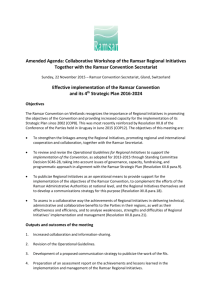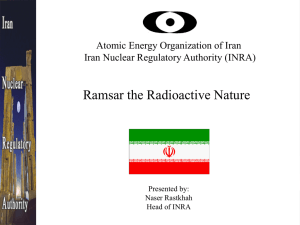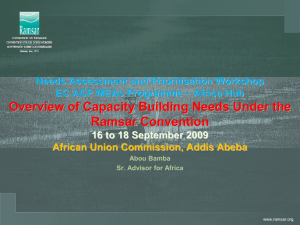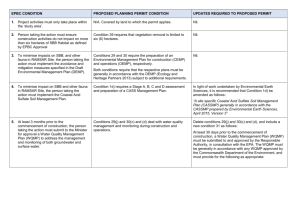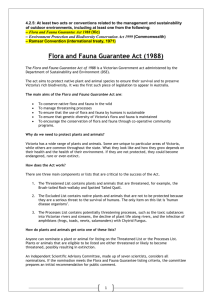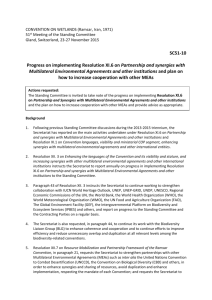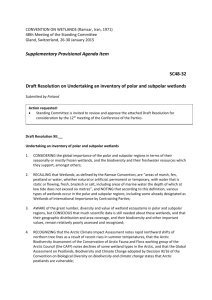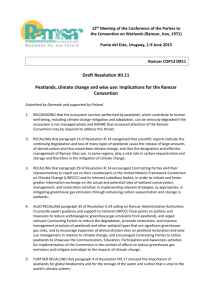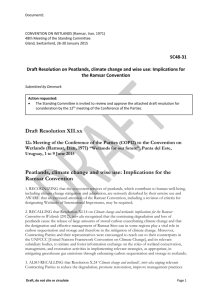English (Word)
advertisement
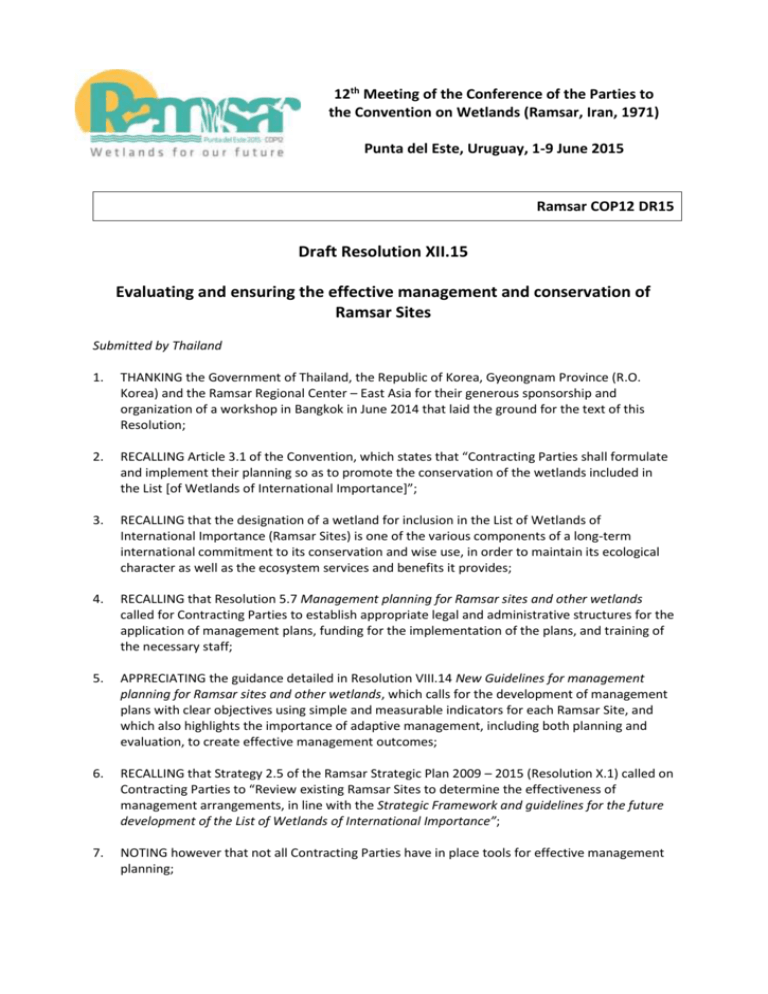
12th Meeting of the Conference of the Parties to the Convention on Wetlands (Ramsar, Iran, 1971) Punta del Este, Uruguay, 1-9 June 2015 Ramsar COP12 DR15 Draft Resolution XII.15 Evaluating and ensuring the effective management and conservation of Ramsar Sites Submitted by Thailand 1. THANKING the Government of Thailand, the Republic of Korea, Gyeongnam Province (R.O. Korea) and the Ramsar Regional Center – East Asia for their generous sponsorship and organization of a workshop in Bangkok in June 2014 that laid the ground for the text of this Resolution; 2. RECALLING Article 3.1 of the Convention, which states that “Contracting Parties shall formulate and implement their planning so as to promote the conservation of the wetlands included in the List [of Wetlands of International Importance]”; 3. RECALLING that the designation of a wetland for inclusion in the List of Wetlands of International Importance (Ramsar Sites) is one of the various components of a long-term international commitment to its conservation and wise use, in order to maintain its ecological character as well as the ecosystem services and benefits it provides; 4. RECALLING that Resolution 5.7 Management planning for Ramsar sites and other wetlands called for Contracting Parties to establish appropriate legal and administrative structures for the application of management plans, funding for the implementation of the plans, and training of the necessary staff; 5. APPRECIATING the guidance detailed in Resolution VIII.14 New Guidelines for management planning for Ramsar sites and other wetlands, which calls for the development of management plans with clear objectives using simple and measurable indicators for each Ramsar Site, and which also highlights the importance of adaptive management, including both planning and evaluation, to create effective management outcomes; 6. RECALLING that Strategy 2.5 of the Ramsar Strategic Plan 2009 – 2015 (Resolution X.1) called on Contracting Parties to “Review existing Ramsar Sites to determine the effectiveness of management arrangements, in line with the Strategic Framework and guidelines for the future development of the List of Wetlands of International Importance”; 7. NOTING however that not all Contracting Parties have in place tools for effective management planning; 8. RECALLING that Annex E of Resolution IX.1 provided an integrated framework for wetland inventory, assessment and monitoring, but AWARE that there is currently no agreed process for evaluating the effectiveness of Ramsar Site management and its outcomes; 9. NOTING the adoption and use of Protected Area Management Evaluation (PAME) tools by networks of protected areas such as World Heritage Sites and ASEAN Heritage Parks, and by institutions with a role in supporting their effective management, such as the World Bank and the Global Environment Facility; 10. FURTHER NOTING the Convention on Biological Diversity’s Decision X/31 of 2010, that called for the institutionalization of management effectiveness assessment, for 60% of the total area of protected areas to be assessed by 2015, and for the results of the assessments to be implemented; and 11. ALSO RECALLING CBD Decision XI/24 which invited the Ramsar Convention and other partners to align their activities to best support the implementation of national work programmes on protected areas, including the development and implementation of management effectiveness evaluations for protected areas and ecological networks; THE CONFERENCE OF THE PARTIES Ramsar Site management planning: 12. ENCOURAGES Contracting Parties to ensure that the Ramsar Site management authority and managers develop and maintain an integrated system of planning, management and evaluation which promotes the wise use of all their Sites; 13. INVITES Ramsar Site management authorities and managers to assess and measure the full range of services that their Site provides (such as the storage, treatment and provision of water, support to the livelihoods and health of human communities, disaster risk reduction, climate change adaptation and mitigation, biodiversity conservation, tourism and education) and to prioritize the maintenance of these services in their management processes; 14. REQUESTS the Ramsar Secretariat and its scientific and technical bodies and officers to consider, within available resources, to summarize the management planning guidelines adopted in Resolution VIII.14 for wide distribution and INVITES Contracting Parties to support the translation of the summary into languages which are not official languages of the Ramsar Convention; 15. ENCOURAGES Contracting Parties to support mechanisms such as networks of Site managers that communicate among themselves virtually and where possible in regular meetings, and establish such networks where they are not already in place, to enable Ramsar Site managers to share experiences and discuss issues of common concern; 16. URGES Contracting Parties to encourage Ramsar Site managers to use Ramsar communication tools including websites and social media to exchange and promote good practice on wetland management practice more widely; Evaluating the effectiveness of Ramsar Site management: Ramsar COP12 DR15 2 17. EMPHASIZES the importance of evaluating the management effectiveness of Ramsar Sites and, where mechanisms are not already in place, that some Contracting Parties may find it useful to adopt appropriate Protected Area Management Evaluation (PAME) tools for effective management; and URGES the Ramsar Secretariat, Scientific and Technical Review Panel (STRP), International Organization Partners (IOPs), Ramsar Regional Centres and other Partners to consider supporting the Contracting Parties in their efforts; 18. ENCOURAGES Contracting Parties that do not already have effective mechanisms in place for effective management planning of their Ramsar Sites to consider using the Ramsar Site Management Effectiveness Tracking Tool (R-METT), which has been developed by the Ramsar Convention and which is annexed to this Resolution; 19. ENCOURAGES Ramsar Site managers to evaluate the effectiveness of the management of each of their Ramsar Sites in collaboration with relevant stakeholders as appropriate; and 20. ENCOURAGES Site managers who use R-METT to complement their use of the R-METT by monitoring and evaluating management outcomes in line with the Integrated Framework for wetland inventory, assessment and monitoring approved as Annex E of Resolution IX.1, and relevant guidelines and good practices identified by Ramsar partners. Ramsar COP12 DR15 3 Annex 1 Ramsar Site Management Effectiveness Tracking Tool (R-METT) 1. The process by which Ramsar Contracting Parties identify wetlands within their territories for inclusion in the List of Wetlands of International Importance, and then ensure the long-term management and conservation of those ‘Ramsar Sites’, is one of the cornerstones of the implementation of the Convention. As of 2014, over 2,100 Sites had been designated, making this the largest network of wetland conservation areas worldwide. 2. For the wise use of Ramsar Sites to be ensured, Site managers must be able to anticipate new issues and to respond to them rapidly and effectively. To make this possible, they should conduct regular and open assessments of the effectiveness of the management of the Site, and learn from both successes and failures. The Ramsar Convention acknowledges the importance of management effectiveness evaluation through Resolution IX.1 Annex D, which provides ecological ‘outcome-oriented’ indicators for assessing the implementation effectiveness of the Convention. 3. A range of Protected Area Management Effectiveness (PAME) assessment tools are available. One of the longest-serving of these is the Management Effectiveness Tracking Tool (METT) published by WWF and the World Bank in 20031. In 20052 and 20083, studies found the METT suitable to evaluate the management effectiveness of Ramsar Sites. 4. In June 2014, a workshop was held in Bangkok, Thailand, to look further into the Ramsar Convention adopting a PAME tool for use at Ramsar Sites. It was hosted by the Government of Thailand and supported by the Government of the R.O. Korea, Gyeongnam Province (R.O. Korea) and the Ramsar Regional Center – East Asia; participants included National Focal Points from each of the Ramsar regions as well as STRP Focal Points and other Ramsar partners. They acknowledged that certain Contracting Parties had already adopted a PAME tool, and recommended that others adopt a Ramsar-adapted version of the METT for use at their Ramsar Sites. 5. The Ramsar-adapted METT, or R-METT, comprises the following sections: Data Sheet 1a: Reporting Progress at Ramsar Sites. This records basic information about the Site, such as its name, size and location. Data Sheet 1b: Identifying and describing values from the Ecological Character Description and the Ramsar Information Sheet. This provides information on the ecological character of the Site including the ecosystem services that it provides, and the Criteria under which the Site qualifies as a Wetland of International Importance. 1 Anon., 2007. Management Effectiveness Tracking Tool Reporting Progress at Protected Area Sites: Second Edition. WWF International and World Bank. 2 Chatterjee, A. and Pittock, J. 2005. Piloting the management effectiveness tracking tool in Ramsar sites. A report from WWF to the Ramsar Convention and its Scientific and Technical Review Panel. WWF. Gland, Switzerland. 3 UNEP-WCMC, 2008. Effectively managing the world’s wetlands: An analysis of applications of the Management Effectiveness Tracking Tool in Ramsar sites. UNEP-WCMC. Cambridge, U.K. Ramsar COP12 DR15 4 Data Sheet 2: National and International Designations. This records information on international designations: i.e. UNESCO World Heritage, Man and Biosphere sites and Ramsar wetland sites. Data Sheet 3: Ramsar Sites Threats. This provides a generic list of threats which Ramsar Sites can face. Data Sheet 4: Assessment form. The assessment is structured around 35 questions presented in table format which includes three columns for recording details of the assessment, all of which should be completed. Data Sheet 5: Trends in Ramsar Ecological Character (including ecosystem services and community benefits)4 This section provides information on trends over the past five years in the ecological character of the Site including the ecosystem services that it provides, and the Criteria under which the Site qualifies as a Ramsar Site. 6. Data Sheets 1 to 4 are adapted from the METT1, but Data Sheet 5 is adapted from the IUCN Conservation Assessment4 for World Heritage Sites. While Data Sheets 1 to 4 focus mainly on the context, planning, inputs, process and outputs sections of the management effectiveness cycle5, Data Sheet 5 focuses on outcomes. 7. Ramsar Contracting Parties are invited to use this R-METT to evaluate the management effectiveness of their Ramsar Sites if they have not already adopted a PAME tool; 4 IUCN, 2012, IUCN Conservation Outlook Assessments - Guidelines for their application to natural World Heritage Sites. Version 1.3. IUCN. Gland, Switzerland. 5 Hockings, M., Stolton, S., Dudley, N., Leverington, F. and Courrau, J., 2006. Evaluating effectiveness: a framework for assessing the management of protected areas. Second edition. IUCN, Gland, Switzerland and Cambridge, UK. Ramsar COP12 DR15 5 Data Sheet 1a: Reporting Progress at Ramsar Sites Name, affiliation and contact details for person responsible for completing the METT (email etc.) Date assessment carried out Name of Ramsar Site Country: Date when Ramsar Site listed: Total Area of Ramsar Site (ha): Ramsar Site number (see http://ramsar.wetlands.org/Database) WDPA Ramsar Site code (see www.unepwcmc.org/wdpa/) Location of Ramsar Site (province and if possible map reference of centre point) List any other International Designations e.g. World Heritage (and fill in section 2 where relevant): Ownership details (please tick all that apply): State Private Community Other Management Authority: Number of staff: Permanent Temporary Total annual budget (US$) for Ramsar Site– excluding staff salary costs: Under which Ramsar criteria was the site designated? Recurrent (operational) funds: Project/ other supplementary funds: List the management objectives of the Ramsar Site Management objective 1: Management objective 2: etc. No. of people involved in completing assessment Including: (tick boxes) PA manager PA staff Other PA agency staff Local community Donors External experts Ramsar Site manager NGO Other Government representative Please note if assessment was carried out in association with a particular project, on behalf of an organisation or donor. Ramsar COP12 DR15 6 Data Sheet 1b: Identifying and describing values from the Ecological Character Description and the Ramsar Information Sheet PART A: RAMSAR CRITERIA – reflects the criteria used for site designation No. Key values Description 1i e.g. Only known breeding area for the New Zealand crane e.g. Large freshwater wetland areas immediately above high tide provide nesting sites and food for rearing chicks. Island location means no interference from feral animals or from vehicles. PART B - OTHER IMPORTANT FEATURES – from the Ecological Character Description or other knowledge of site managers. Vn° Key values Description Vx Key area for community- based Provides primary food source for local population of approx. fishing industry 2000 villagers Ramsar COP12 DR15 Ramsar Criterion e.g. Criterion 2 ECD group Ecological services and benefits 7 Data Sheet 2: National and International Designations Nationally designated Protected Areas which fall within the boundaries of the Ramsar Site (add extra columns as required): Name Designation IUCN category Area (ha) Date of Establishment WDPA code UNESCO World Heritage site (see: whc.unesco.org/en/list) Site name Site area (ha) Date Listed Geographical co-ordinates WDPA Code Criteria for designation (i.e. criteria i to x) Statement of Outstanding Universal Value UNESCO Man and Biosphere Reserves (see: www.unesco.org/mab/wnbrs.shtml) Site name Date listed Site area (ha): Total: Geographical co-ordinates Core: Buffer: Transition Criteria for designation Fulfillment of three functions of MAB (conservation, development and logistic support.) Please list other designations (i.e. ASEAN Heritage, Natura 2000) and any supporting information below Name: Ramsar COP12 DR15 Details: 8 Data Sheet 3: Ramsar Sites Threats Please tick all relevant existing threats as either of high, medium or low significance. Note that some of the activities listed are not always threats – only tick them if they threaten the site’s integrity in some way. Threats ranked as of high significance are those which are seriously degrading values; medium are those threats having some negative impact and those characterized as low are threats which are present but not seriously impacting values or N/A where the threat is not present or not applicable in the Ramsar Site. 1. Residential and commercial development within a Ramsar Site Threats from human settlements or other non-agricultural land uses with a substantial footprint High Medium Low N/A Threat Notes 1.1 Housing and settlement 1.2 Commercial and industrial areas 1.3 Tourism and recreation infrastructure 2. Agriculture and aquaculture within a Ramsar Site Threats from farming and grazing as a result of agricultural expansion and intensification, including silviculture, mariculture and aquaculture High Medium Low N/A Threat Notes 2.1 Annual and perennial non-timber crop cultivation 2.1a Drug cultivation 2.2 Wood and pulp plantations 2.3 Livestock farming and grazing 2.4 Marine and freshwater aquaculture 3. Energy production and mining within a Ramsar Site Threats from production of non-biological resources High Medium Low N/A Threat Notes 3.1 Oil and gas drilling 3.2 Mining and quarrying 3.3 Energy generation, including from hydropower dams, wind farms and solar panels 4. Transportation and service corridors within a Ramsar Site Threats from long narrow transport corridors and the vehicles that use them including associated wildlife mortality High Medium Low N/A Threat Notes 4.1 Roads and railroads (include road-killed animals) 4.2 Utility and service lines (e.g. electricity cables, telephone lines,) 4.3 Shipping lanes and canals 4.4 Flight paths 5. Biological resource use and harm within a Ramsar Site Threats from consumptive use of "wild" biological resources including both deliberate and unintentional harvesting effects; also persecution or control of specific species (note this includes hunting and killing of animals) High Medium Low N/A Threat Notes 5.1 Hunting, killing and collecting terrestrial (native) animals (including killing of animals as a result of human/wildlife conflict) 5.2 Gathering terrestrial (native) plants or plant products (non-timber) 5.3 Logging and wood harvesting 5.4 Fishing, killing and harvesting (native) aquatic resources Ramsar COP12 DR15 9 6. Human intrusions and disturbance within a Ramsar Site Threats from human activities that alter, destroy or disturb habitats and species associated with non-consumptive uses of biological resources High Medium Low N/A Threat Notes 6.1 Recreational activities and tourism 6.2 War, civil unrest and military exercises 6.3 Research, education and other work-related activities in Ramsar Site 6.4 Activities of site managers (e.g. construction or vehicle use, artificial watering points and dams) 6.5 Deliberate vandalism, destructive activities or threats to protected area staff and visitors 7. Natural system modifications Threats from other actions that convert or degrade habitat or change the way the ecosystem functions. High Medium Low N/A Threat Notes 7a1 Habitat clearing 7.1 Fire and fire suppression (including arson) 7.2 Dams, hydrological modification and water management/use 7.3a Increased fragmentation within Ramsar Site 7.3b Isolation from other natural habitat (e.g. deforestation, dams without effective aquatic wildlife passages) 7.3c Other ‘edge effects’ on park values 7.3d Loss of keystone species (e.g. top predators, pollinators etc) 7a. Hydrological change High Medium Low N/A Threat 13.1 Dams within or upstream of site altering hydrological regime 13.2 Water extraction/diversion within site or catchment 13.3 Excess ponding of water in site (e.g. for flood storage) 13.4 Loss of hydrological connectivity (e.g. via stop banks) 13.5 Drought conditions Notes 8. Invasive and other problematic species and genes Threats from terrestrial and aquatic non-native and native plants, animals, pathogens/microbes or genetic materials that have or are predicted to have harmful effects on biodiversity following introduction, spread and/or increase High Medium Low N/A Threat Notes 8.1 Invasive non-native/alien plants (weeds) 8.1a Invasive non-native/alien animals 8.1b Pathogens (non-native or native but creating new/increased problems) 8.2 Introduced genetic material (e.g. genetically modified organisms) Ramsar COP12 DR15 10 9. Pollution entering or generated within Ramsar Site Threats from introduction of exotic and/or excess materials or energy from point and non-point sources High Medium Low N/A Threat Notes 9.1 Household sewage and urban waste water 9.1a Sewage and waste water from Ramsar Site facilities (e.g. toilets, hotels etc) 9.2 Industrial, mining and military effluents and discharges (e.g. unnatural temperatures, deoxygenated, higher salinity, other pollution) 9.3 Agricultural and forestry effluents (e.g. excess fertilizers or pesticides) 9.4 Garbage and solid waste 9.5 Air-borne pollutants 9.6 Excess energy (e.g. heat pollution, lights etc) 10. Geological events Geological events may be part of natural disturbance regimes in many ecosystems but they can be a threat if a species or habitat is damaged and has lost its resilience and is vulnerable to disturbance. Management capacity to respond to some of these changes may be limited. High Medium Low N/A Threat Notes 10.1 Volcanoes 10.2 Earthquakes/Tsunamis 10.3 Avalanches/ Landslides 10.4 Erosion and siltation/ deposition (e.g. shoreline or riverbed changes) 11. Climate change and severe weather Threats from long-term climatic changes which may be linked to global warming and other severe climatic/weather events outside of the natural range of variation High Medium Low N/A Threat Notes 11.1 Habitat shifting and alteration 11.2 Droughts 11.3 Temperature extremes 11.4 Storms and flooding 12. Specific cultural and social threats High Medium Low Ramsar COP12 DR15 N/A Threat 12.1 Loss of cultural links, traditional knowledge and/or management practices 12.2 Natural deterioration of important cultural site values 12.3 Destruction of cultural heritage buildings, gardens, sites etc Notes 11 Data Sheet 4: Assessment form Issue Criteria 1. Legal status The Ramsar Site is not gazetted/covenanted 0 Does the Ramsar Site have legal status (or in the case of private reserves is covered by a covenant or similar)? There is agreement that the Ramsar Site should be gazetted/covenanted but the process has not yet begun 1 The Ramsar Site is in the process of being gazetted/covenanted but the process is still incomplete (includes sites designated under international conventions, such as Ramsar, or local/traditional law such as community conserved areas, which do not yet have national legal status or covenant) 2 The Ramsar Site has been formally gazetted/covenanted 3 There are no regulations for controlling land use and activities in the Ramsar Site Some regulations for controlling land use and activities in the Ramsar Site exist but these are major weaknesses Regulations for controlling land use and activities in the Ramsar Site exist but there are some weaknesses or gaps Regulations for controlling inappropriate land use and activities in the Ramsar Site exist and provide an excellent basis for management 0 The staff have no effective capacity/resources to enforce Ramsar Site legislation and regulations There are major deficiencies in staff capacity/resources to enforce Ramsar Site legislation and regulations (e.g. lack of skills, no patrol budget, lack of institutional support) The staff have acceptable capacity/resources to enforce Ramsar Site legislation and regulations but some deficiencies remain The staff have excellent capacity/resources to enforce Ramsar Site legislation and regulations 0 No firm objectives have been agreed for the Ramsar Site 0 The Ramsar Site has agreed objectives, but is not managed according to these objectives The Ramsar Site has agreed objectives, but is only partially managed according to these objectives 1 Context 2. Ramsar Site regulations Are regulations in place to control land use and activities (e.g. hunting)? Planning 3. Law enforcement Can staff (i.e. those with responsibility for managing the site) enforce Ramsar Site rules well enough? Input 4. Ramsar Site objectives Is management undertaken according Ramsar COP12 DR15 Score: Tick only one box per question Comment/Explanation Next steps 1 2 3 1 2 3 2 12 Issue Criteria to agreed objectives? The Ramsar Site has agreed objectives and is managed to meet these objectives 3 Inadequacies in Ramsar Site design mean achieving the major objectives of the Ramsar Site is very difficult 0 Inadequacies in Ramsar Site design mean that achievement of major objectives is difficult but some mitigating actions are being taken (e.g. agreements with adjacent land owners for wildlife corridors or introduction of appropriate catchment management) Ramsar Site design is not significantly constraining achievement of objectives, but could be improved (e.g. with respect to larger scale ecological processes) Ramsar Site design helps achievement of objectives; it is appropriate for species and habitat conservation; and maintains ecological processes such as surface and groundwater flows at a catchment scale, natural disturbance patterns etc The boundary of the Ramsar Site is not known by the management authority or local residents/neighbouring land users The boundary of the Ramsar Site is known by the management authority but is not known by local residents/neighbouring land users The boundary of the Ramsar Site is known by both the management authority and local residents/neighbouring land users but is not appropriately demarcated The boundary of the Ramsar Site is known by the management authority and local residents/neighbouring land users and is appropriately demarcated 1 There is no management plan for the Ramsar Site 0 A management plan is being prepared or has been prepared but is not being implemented A management plan exists but it is only being partially implemented because of funding constraints or other problems A management plan exists and is being implemented 1 Planning 5. Ramsar Site design Is the Ramsar Site the right size and shape to protect species, habitats, ecological processes and water catchments of key conservation concern? Planning 6. Ramsar Site boundary demarcation Is the boundary known and demarcated? Process 7. Management plan Is there a management plan and is it being implemented? Planning Score: Tick only one box per question Comment/Explanation Next steps 2 3 0 1 2 3 2 3 Additional points: Planning Ramsar COP12 DR15 13 Issue Criteria 7a. Planning process The planning process allows adequate opportunity for key stakeholders to influence the management plan +1 7b. Planning process There is an established schedule and process for periodic review and updating of the management plan +1 7c. Planning process The results of monitoring, research and evaluation are routinely incorporated into planning No regular work plan exists +1 A regular work plan exists but few of the activities are implemented 1 A regular work plan exists and many activities are implemented 2 A regular work plan exists and all activities are implemented 3 There is little or no information available on the critical habitats, species and cultural values of the Ramsar Site Information on the critical habitats, species, ecological processes and cultural values of the Ramsar Site is not sufficient to support planning and decision making Information on the critical habitats, species, ecological processes and cultural values of the Ramsar Site is sufficient for most key areas of planning and decision making Information on the critical habitats, species, ecological processes and cultural values of the Ramsar Site is sufficient to support all areas of planning and decision making Protection systems (patrols, permits etc) do not exist or are not effective in controlling access/resource use Protection systems are only partially effective in controlling access/resource use Protection systems are moderately effective in controlling access/resource use Protection systems are largely or wholly effective in controlling access/ resource use There is no survey or research work taking place in the Ramsar Site 0 There is a small amount of survey and research work but it is not directed towards the needs of Ramsar Site management 1 8. Regular work plan Is there a regular work plan and is it being implemented Planning/Outputs 9. Resource inventory Do you have enough information to manage the area? Input 10. Protection systems Are systems in place to control access/resource use in the Ramsar Site? Process/Outcome 11. Research Is there a programme Ramsar COP12 DR15 Score: Tick only one box per question Comment/Explanation Next steps 0 1 2 3 0 1 2 3 0 14 Issue Criteria of managementorientated survey and research work? There is considerable survey and research work but it is not directed towards the needs of Ramsar Site management There is a comprehensive, integrated programme of survey and research work, which is relevant to management needs 2 0 1 Process Active resource management is not being undertaken Very few of the requirements for active management of critical habitats, species, ecological processes and cultural values are being implemented Many of the requirements for active management of critical habitats, species, ecological processes and, cultural values are being implemented but some key issues are not being addressed Requirements for active management of critical habitats, species, ecological processes and, cultural values are being substantially or fully implemented 13. Staff numbers There are no staff 0 Are there enough people employed to manage the Ramsar Site? Staff numbers are inadequate for critical management activities 1 Staff numbers are below optimum level for critical management activities 2 Inputs Staff numbers are adequate for the management needs of the Ramsar Site 3 14. Staff training Staff lack the skills needed for Ramsar Site management 0 Are staff adequately trained to fulfil management objectives? Staff training and skills are low relative to the needs of the Ramsar Site Staff training and skills are adequate, but could be further improved to fully achieve the objectives of management Staff training and skills are aligned with the management needs of the Ramsar Site 1 2 There is no budget for management of the Ramsar Site 0 The available budget is inadequate for basic management needs and presents a serious constraint to the capacity to manage The available budget is acceptable but could be further improved to fully achieve effective management 1 Process 12. Resource management Is active resource management being undertaken? Inputs/Process 15. Current budget Is the current budget sufficient? Ramsar COP12 DR15 Score: Tick only one box per question Comment/Explanation Next steps 3 2 3 3 2 15 Issue Criteria Inputs The available budget is sufficient and meets the full management needs of the Ramsar Site There is no secure budget for the Ramsar Site and management is wholly reliant on outside or highly variable funding There is very little secure budget and the Ramsar Site could not function adequately without outside funding There is a reasonably secure core budget for regular operation of the Ramsar Site but many innovations and initiatives are reliant on outside funding There is a secure budget for the Ramsar Site and its management needs 3 Budget management is very poor and significantly undermines effectiveness (e.g. late release of budget in financial year) Budget management is poor and constrains effectiveness 0 Is the budget managed to meet critical management needs? Budget management is adequate but could be improved 2 Process Budget management is excellent and meets management needs 3 18. Equipment There are little or no equipment and facilities for management needs 0 Is equipment sufficient for management needs? There are some equipment and facilities but these are inadequate for most management needs There are equipment and facilities, but still some gaps that constrain management There are adequate equipment and facilities 1 There is little or no maintenance of equipment and facilities 0 There is some ad hoc maintenance of equipment and facilities 1 There is basic maintenance of equipment and facilities 2 Equipment and facilities are well maintained 3 16. Security of budget Is the budget secure? Score: Tick only one box per question Comment/Explanation Next steps 0 1 2 3 Inputs 17. Management of budget Input 19. Maintenance of equipment Is equipment adequately maintained? 1 2 3 Process Ramsar COP12 DR15 16 Issue Criteria 20. Education and awareness There is no education and awareness programme 0 There is a limited and ad hoc education and awareness programme 1 There is an education and awareness programme but it only partly meets needs and could be improved 2 There is an appropriate and fully implemented education and awareness programme Adjacent land and water use planning does not take into account the needs of the Ramsar Site and activities/policies are detrimental to the survival of the area Adjacent land and water use planning does not take into account the long term needs of the Ramsar Site, but activities are not detrimental the area Adjacent land and water use planning partially takes into account the long term needs of the Ramsar Site Adjacent land and water use planning fully takes into account the long term needs of the Ramsar Site 3 Planning and management in the catchment or landscape containing the Ramsar Site incorporates provision for adequate environmental conditions (e.g. volume, quality and timing of water flow, air pollution levels etc) to sustain relevant habitats. Management of corridors linking the Ramsar Site provides for wildlife passage to key habitats outside the Ramsar Site (e.g. to allow migratory fish to travel between freshwater spawning sites and the sea, or to allow animal migration). "Planning addresses ecosystem-specific needs and/or the needs of particular species of concern at an ecosystem scale (e.g. volume, quality and timing of freshwater flow to sustain particular species, fire management to maintain savannah habitats etc.)" There is no contact between managers and neighbouring official or corporate land and water users There is contact between managers and neighbouring official or corporate land and water users but little or no cooperation +1 Is there a planned education programme linked to the objectives and needs? Process 21. Planning for land and water use Does land and water use planning recognise the Ramsar Site and aid the achievement of objectives? Score: Tick only one box per question Comment/Explanation Next steps 0 1 2 3 Planning Additional points: Land and water planning 21a: Land and water planning for habitat conservation 21b: Land and water planning for connectivity 21c: Land and water planning for ecosystem services & species conservation 22. State and commercial neighbours Ramsar COP12 DR15 +1 +1 0 1 17 Issue Criteria Is there co-operation with adjacent land and water users? There is contact between managers and neighbouring official or corporate land and water users, but only some co-operation There is regular contact between managers and neighbouring official or corporate land and water users, and substantial co-operation on management 2 Indigenous and traditional peoples have no input into decisions relating to the management of the Ramsar Site 0 Indigenous and traditional peoples have some input into discussions relating to management but no direct role in management 1 Indigenous and traditional peoples directly contribute to some relevant decisions relating to management but their involvement could be improved 2 Indigenous and traditional peoples directly participate in all relevant decisions relating to management, e.g. co-management 3 Local communities have no input into decisions relating to the management of the Ramsar Site Local communities have some input into discussions relating to management but no direct role in management Local communities directly contribute to some relevant decisions relating to management but their involvement could be improved Local communities directly participate in all relevant decisions relating to management, e.g. co-management 0 24 a. Impact on communities 24b. Impact on communities 24c. Impact on communities There is open communication and trust between local and/or indigenous people, stakeholders and Ramsar Site managers Programmes to enhance community welfare, while conserving Ramsar Site resources, are being implemented Local and/or indigenous people actively support the Ramsar Site +1 25. Economic benefit The Ramsar Site does not deliver any economic benefits to local communities Potential economic benefits are recognised and plans to realise these are being developed 0 1 Process 23. Indigenous people Do indigenous and traditional peoples resident or regularly using the Ramsar Site have input to management decisions? Process 24. Local communities Do local communities resident or near the Ramsar Site have input to management decisions? Process Additional points Local communities/indigenous people Is the Ramsar Site Ramsar COP12 DR15 Score: Tick only one box per question Comment/Explanation Next steps 3 1 2 3 +1 +1 18 Issue Criteria providing economic benefits to local communities, e.g. income, employment, payment for environmental services? There is some flow of economic benefits to local communities 2 There is a major flow of economic benefits to local communities from activities associated with the Ramsar Site 3 There is no monitoring and evaluation in the Ramsar Site 0 There is some ad hoc monitoring and evaluation, but no overall strategy and/or no regular collection of results There is an agreed and implemented monitoring and evaluation system but results do not feed back into management A good monitoring and evaluation system exists, is well implemented and used in adaptive management There are no visitor facilities and services despite an identified need 1 Visitor facilities and services are inappropriate for current levels of visitation Visitor facilities and services are adequate for current levels of visitation but could be improved Visitor facilities and services are excellent for current levels of visitation 1 2 There is little or no contact between managers and tourism operators using the Ramsar Site There is contact between managers and tourism operators but this is largely confined to administrative or regulatory matters There is limited co-operation between managers and tourism operators to enhance visitor experiences and maintain Ramsar Site values There is good co-operation between managers and tourism operators to enhance visitor experiences, and maintain Ramsar Site values 0 Although fees are theoretically applied, they are not collected 0 Fees are collected, but make no contribution to the Ramsar Site or its environs 1 Outcomes 26. Monitoring and evaluation Are management activities monitored against performance? Planning/Process 27. Visitor facilities Are visitor facilities adequate? Outputs 28. Commercial tourism operators Do commercial tour operators contribute to Ramsar Site management? Process 29. Fees If fees (i.e. entry fees Ramsar COP12 DR15 Score: Tick only one box per question Comment/Explanation Next steps 2 3 0 3 1 2 3 19 Issue Criteria or fines) are applied, do they help Ramsar Site management? Fees are collected, and make some contribution to the Ramsar Site and its environs Fees are collected and make a substantial contribution to the Ramsar Site and its environs Inputs/Process 30. Condition of key management targets What is the condition of the important values of the Ramsar Site as compared to when it was first designated? (this answer should be a conclusion from datasheet 5) Many important biodiversity, ecological or cultural values are being severely degraded Some biodiversity, ecological or cultural values are being severely degraded Some biodiversity, ecological and cultural values are being partially degraded but the most important values have not been significantly impacted Biodiversity, ecological and cultural values are predominantly intact 32: Cross sectorial Comment/Explanation Next steps 2 3 0 1 2 3 Outcomes Additional Points: Condition of values 30a: Condition of The assessment of the condition of values is based on research and/or values monitoring 30b: Condition of Specific management programmes are being implemented to address threats values to biodiversity, ecological and cultural values 30c: Condition of Activities to maintain key biodiversity, ecological and cultural values are a values routine part of management Additional questions specific to Ramsar Sites: 31: Ecological Character Description Score: Tick only one box per question Work on the description of the ecological character of the Ramsar Site has not begun Work has begun to create a description of the ecological character of the Ramsar Site, but no draft is yet available A description of the ecological character of the site has been drafted, but is incomplete or out of date A description of the ecological character of the site has been completed No cross-sectorial management committee is in place Ramsar COP12 DR15 +1 +1 +1 0 1 2 3 0 20 Issue Criteria Management Committee Potential stakeholders for the creation of a cross-sectorial management committee have been identified, but no management committee has been established A management committee has been established, but is not significantly involved in the management of the site A functioning cross-sectorial management committee is in place There are no mechanisms in place for communication between the Ramsar Administrative authority and site managers Communication between the Ramsar Administrative authority and site managers exists but is ad-hoc and poorly developed Communication mechanisms are in place but could be improved Mechanisms are in place for communication between the Ramsar Administrative authority and site managers and function well 33. Communication mechanisms with Ramsar administrative authority 34. Of the 33 questions above, please list in order of importance the five that reflect the major constraints to effective management of your Ramsar Site Ramsar COP12 DR15 Score: Tick only one box per question Question number Comment/Explanation Next steps 1 2 3 0 1 2 3 Why is this a major constraint to effective management 21 35. Of the 33 questions above, please list in order of importance the five greatest strengths of your current management of your Ramsar Site Ramsar COP12 DR15 Question number Why do you think this has become a strength of current management? (e.g. due to manager’s efforts or government commitment? 22 Data Sheet 5: Trends in Ramsar Ecological Character (including ecosystem services and community benefits) Key values for the Ramsar Site should be copied from Datasheet 1a., then indicate the current condition of the value and the trend over the past five years Note: The current state of values is assessed against five ratings: Good, Low Concern, High Concern, Critical and Data Deficient. The baseline for the assessment should be the condition at the time of designation, with reference to the best-recorded historical conservation state. Trend is assessed in relation to whether the condition of a value is Improving, Stable, Deteriorating or Data Deficient, and is intended to be snapshot of recent developments over the last three years. PART A: RAMSAR CRITERIA – reflects the criteria used for site designation Assessment Values Good Justification of assessment Trend Low Concern High Concern Critical Data deficient I S D DD PART B - OTHER IMPORTANT FEATURES – from the Ecological Character Description or other knowledge of site managers. Assessment of the overall current state and trend of Ramsar Site ecological character: Ramsar COP12 DR15 23

